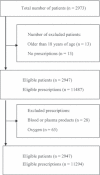Paediatric drug use with focus on off-label prescriptions at Swedish hospitals - a nationwide study
- PMID: 22404126
- PMCID: PMC3437470
- DOI: 10.1111/j.1651-2227.2012.02656.x
Paediatric drug use with focus on off-label prescriptions at Swedish hospitals - a nationwide study
Abstract
Aim: To perform a nationwide investigation of paediatric drug use at Swedish hospitals, including an analysis of off-label drug use.
Methods: All paediatric hospitals in Sweden were invited to register all prescriptions to children, aged between 0 and 18, during two separate 2-day-periods in 2008. Data were reported and analysed with respect to licence status and proportion of and reasons for off-label drug use.
Results: Data on 11,294 prescriptions to 2947 paediatric patients were received. Drugs associated with pain relief, infection, prematurity, nutrition and surgery or anaesthesia were most commonly used. Paracetamol was the most frequently used drug on-label and also among the most commonly used off-label drugs. Nearly half (49%) of all administered prescriptions concerned unlicensed drugs, off-label drugs or extemporaneously prepared drugs. The corresponding rate among neonates was 69%. Lack of paediatric information in the Summary of Product Characteristics was the main reason for off-label classification.
Conclusions: Paediatric off-label drug use is common at Swedish hospitals, and nearly half of all prescriptions were not documented for use in children. The findings emphasize a need for paediatric clinical studies as well as compilation of existing clinical experience and scattered evidence, particularly for drug treatment in infants and neonates.
© 2012 The Author(s)/Acta Paediatrica © 2012 Foundation Acta Paediatrica.
Figures



References
-
- Di Paolo ER, Stoetter H, Cotting J, Frey P, Gehri M, Beck-Popovic M, et al. Unlicensed and off-label drug use in a Swiss paediatric university hospital. Swiss Med Wkly. 2006;136:218–22. - PubMed
-
- t Jong GW, Vulto AG, de Hoog M, Schimmel KJ, Tibboel D, van den Anker JN. A survey of the use of off-label and unlicensed drugs in a Dutch children's hospital. Pediatrics. 2001;108:1089–93. - PubMed
-
- Santos DB, Clavenna A, Bonati M, Coelho HL. Off-label and unlicensed drug utilization in hospitalized children in Fortaleza, Brazil. Eur J Clin Pharmacol. 2008;64:1111–8. - PubMed
-
- Cuzzolin L, Atzei A, Fanos V. Off-label and unlicensed prescribing for newborns and children in different settings: a review of the literature and a consideration about drug safety. Expert Opin Drug Saf. 2006;5:703–18. - PubMed
-
- Pandolfini C, Bonati M. A literature review on off-label drug use in children. Eur J Pediatr. 2005;164:552–8. - PubMed
Publication types
MeSH terms
LinkOut - more resources
Full Text Sources

